

System Theory. Club of Rome. The Club of Rome is a global think tank that deals with a variety of international political issues.
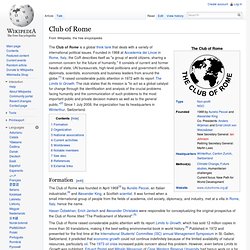
Founded in 1968 at Accademia dei Lincei in Rome, Italy, the CoR describes itself as "a group of world citizens, sharing a common concern for the future of humanity. " It consists of current and former heads of state, UN bureaucrats, high-level politicians and government officials, diplomats, scientists, economists and business leaders from around the globe.[1] It raised considerable public attention in 1972 with its report The Limits to Growth. The club states that its mission is "to act as a global catalyst for change through the identification and analysis of the crucial problems facing humanity and the communication of such problems to the most important public and private decision makers as well as to the general public. "[2] Since 1 July 2008, the organization has its headquarters in Winterthur, Switzerland. Formation[edit] Organization[edit] National associations[edit] Systems theory. Systems theory is the interdisciplinary study of systems in general, with the goal of elucidating principles that can be applied to all types of systems at all nesting levels in all fields of research.
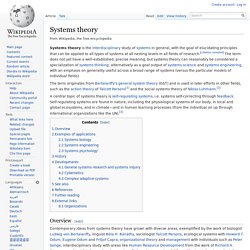
[citation needed] The term does not yet have a well-established, precise meaning, but systems theory can reasonably be considered a specialization of systems thinking; alternatively as a goal output of systems science and systems engineering, with an emphasis on generality useful across a broad range of systems (versus the particular models of individual fields). A central topic of systems theory is self-regulating systems, i.e. systems self-correcting through feedback. System dynamics. Dynamic stock and flow diagram of model New product adoption (model from article by John Sterman 2001) System dynamics is an approach to understanding the behaviour of complex systems over time.
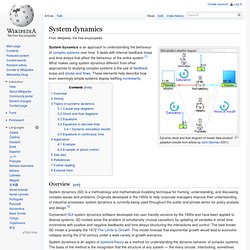
It deals with internal feedback loops and time delays that affect the behaviour of the entire system.[1] What makes using system dynamics different from other approaches to studying complex systems is the use of feedback loops and stocks and flows. These elements help describe how even seemingly simple systems display baffling nonlinearity. Overview[edit] System dynamics (SD) is a methodology and mathematical modeling technique for framing, understanding, and discussing complex issues and problems. Convenient GUI system dynamics software developed into user friendly versions by the 1990s and have been applied to diverse systems.
Twelve leverage points. The twelve leverage points to intervene in a system were proposed by Donella Meadows, a scientist and system analyst focused on environmental limits to economic growth.
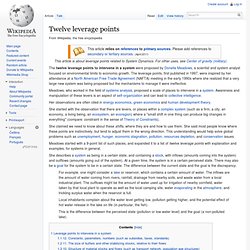
The leverage points, first published in 1997, were inspired by her attendance at a North American Free Trade Agreement (NAFTA) meeting in the early 1990s where she realized that a very large new system was being proposed but the mechanisms to manage it were ineffective. Meadows, who worked in the field of systems analysis, proposed a scale of places to intervene in a system. Awareness and manipulation of these levers is an aspect of self-organization and can lead to collective intelligence. Her observations are often cited in energy economics, green economics and human development theory. She claimed we need to know about these shifts, where they are and how to use them. For example, one might consider a lake or reservoir, which contains a certain amount of water. The Limits to Growth. Five variables were examined in the original model.
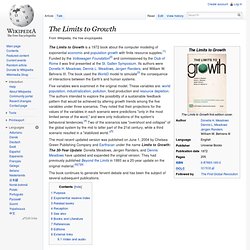
These variables are: world population, industrialization, pollution, food production and resource depletion. The authors intended to explore the possibility of a sustainable feedback pattern that would be achieved by altering growth trends among the five variables under three scenarios. They noted that their projections for the values of the variables in each scenario were predictions "only in the most limited sense of the word," and were only indications of the system's behavioral tendencies.[4] Two of the scenarios saw "overshoot and collapse" of the global system by the mid to latter part of the 21st century, while a third scenario resulted in a "stabilized world.
"[5] The most recent updated version was published on June 1, 2004 by Chelsea Green Publishing Company and Earthscan under the name Limits to Growth: The 30-Year Update. Purpose[edit] Exponential reserve index[edit] , but the rate of chromium consumption was growing at where: